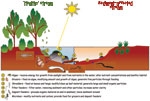PDF of this article (433 KB)



As Ngaire Phillips explains, what organisms do within an ecosystem is as important as who they are.
Streams are complex, living systems characterised by a one-way flow of water. Ecologists tend to divide stream ecosystems into two components – a biotic component (which includes plants, animals, and microbes) and an abiotic component (which includes, for example, energy flow). In reality, these two components are intimately and inextricably linked and a major focus of ecology is to find better ways of describing the linkages between the two. The abiotic component of the ecosystem is continually modified by the actions of the plants and animals within it. We can divide the biotic component on the basis of the functional roles that each group of organisms plays. For example, streams have three main functional groups that help cycle energy through the ecosystem.
- Producers (for example, algae) generate their own food through photosynthesis, drawing on nutrients provided by the water flowing past them.
- Consumers (such as snails) feed on the producers; some consumers (for instance, predatory dragonflies) feed on their fellow consumers.
- Decomposers (such as microbes) break down organic material, including plant and animal matter.
What is functional biodiversity?
While we can measure the physical and chemical processes contributing to ecosystem functioning relatively easily (for example, by measuring nutrient concentrations), such measures don't tell us much about the complex biological and physical interactions that drive the ecosystem processes we observe. What we need instead is a way of measuring the diversity of ecosystem functions found in stream ecosystems, and the contribution that the biotic component makes to these functions. This measure, termed 'functional biodiversity', is analogous to other measures of biodiversity (such as species richness), but focuses more on the diversity, or richness, of ecosystem functions provided by the biological community.
One of the simplest measures of functional biodiversity is the variety of feeding strategies used by organisms within an ecosystem. For example, shredders tear up leaves, twigs, and other large material that falls into the stream into smaller pieces. Collectors are then able to gather these finer particles and use this food resource. Predators feed directly on other animals. Species possess an array of traits or characteristics that reflect their roles in ecosystem functioning. We can use such traits to measure the relative importance of individual species in the functioning of a particular ecosystem.
Functional biodiversity and species biodiversity
So how many species are needed to maintain ecosystem functioning? While every organism contributes to ecosystem processes, the nature and magnitude of individual contributions vary considerably. Most ecosystem processes are driven by the combined activities of many species, and it is often not possible to determine the relative contributions of individual species. At least one species per functional group is essential to maintain ecosystem functioning. Having more than one species per group may not be necessary, but it can provide back-up in case a species is lost, for example, as a consequence of pollution. In addition, it is known that some species have a more important functional role than others. For example, koura, the freshwater crayfish, is an 'ecosystem engineer' that can affect habitat for other stream animals by moving sediment around.
Difficulties of measurement
Few studies have measured functional biodiversity in freshwater ecosystems; most research has concentrated on terrestrial systems, and plant communities in particular. One of the major impediments to understanding the value of functional biodiversity is knowing how to measure it. For example, some experiments show that changes in the number of functional groups alters ecosystem-level processes; however, others have shown no association. Consideration of the relative importance of individual traits, rather than functional groups, may offer an alternative measure of functional biodiversity.
Why is functional biodiversity important?
We know the planet is losing species and habitats, but we don't know enough about how this loss affects the way that ecosystems function. We rely on ecosystem functions for a variety of 'ecosystem services'. Streams provide such services by mitigating drought and floods, detoxifying and decomposing wastes, and maintaining biodiversity. They also provide cultural benefits, such as religious, aesthetic, recreational, or inspirational values. We humans have modified ecosystem processes through changing or destroying habitat, by deliberately or accidentally introducing non-native species, over-exploiting resources, and polluting. Research suggests that a reduction in biodiversity can alter both the magnitude and stability of ecosystem processes. The very ecosystem services we take for granted are directly threatened by loss of species.
Eco-terminology
Ecosystem processes (such as algal production, decomposition, nutrient leaching, or other measures of material production, transport, or loss) are quantified by measuring the rates of movement between the biotic (living) and abiotic (non-living) components of an ecosystem.
Ecosystem functioning is a measure of the changes in these ecosystem processes.
Functional group refers to a group of species performing similar functions (such as grazers or predators) within an ecosystem.
Ecosystem services provided by streams include recreation, flood and drought mitigation, and waste treatment.
Further reading
Naeem, S. and 11 others. (1999). Biodiversity and ecosystem functioning: maintaining natural life support processes. Issues in Ecology 4: 1-11. See www.epa.gov/watertrain/pdf/issue4.pdf
Phillips, N. (2004). Stream biomonitoring using species traits. Water & Atmosphere 12(4): 8-9.
Dr Ngaire Phillips, who studies functional responses to contaminants, is based at NIWA in Hamilton.
Teachers’ resource for NCEA AS: Biology 90164 (1.4), 90460 (2.4), 90462 (2.6), 90713 (3.1). See other curriculum connections at www.niwa.co.nz/pubs/wa/resources
